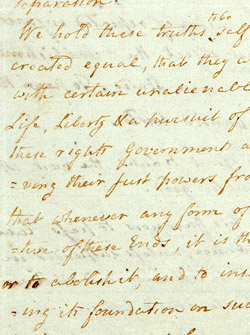
GM 4026.901
Gilcrease Museum’s Certified Copy of the Declaration of Independence, 1777, as well as other items from the vast archival collection, have been moved into the secure vault at the Helmerich Center for American Research on the Gilcrease campus.
The move was a watershed moment for the museum. Since the public preview weekend of the Helmerich Center in September 2014, the museum has been carefully moving the archival material to its new, state-of-the art home. With an inaugural symposium set for March 27-28, 2015, the center and staff led by Executive Director Duane King, Ph.D., are ready to begin unlocking the treasures in the archives.
The Helmerich Center for American Research at Gilcrease Museum will house the museum’s archival collection containing more than 100,000 rare books, manuscripts, documents and maps ranging from 1494 to the present, including important works such as a letter dictated and signed by Diego Columbus in 1512; the Cortez Decree of 1521; copies of the Declaration of Independence and the Articles of Confederation, signed by Benjamin Franklin; a Thomas Jefferson letter dated July 1, 1776; and the John Ross Papers, former Principal Chief of the Cherokee Nation.
The Helmerich Center boasts one of the most advanced fire suppression systems in the world. DuPont™ FM-200® is a waterless fire protectant with a history of protecting some of the world’s most critical and irreplaceable assets. This system deploys quickly and cleanly and won’t leave behind oily residue, particulate or water. FM-200® can reach extinguishing levels in 10 seconds or less, stopping ordinary combustible, electrical and flammable liquid fires before they cause significant damage.
Additionally, the Anne and Henry Zarrow Library and the Hardesty Archival Center in the Helmerich Center were built to withstand wind speeds and damage generated by an F5 tornado.
Electrochromic glass made by View Dynamic Glass was used in the construction of the Helmerich Center to provide protection of priceless works on paper. This new generation of architectural dynamic glass intelligently adjusts in response to external conditions and user preferences enabling unparalleled control to reduce harmful UV rays from the sun.
The Thomas Gilcrease Institute of American History and Art — commonly known as Gilcrease Museum — opened in Tulsa on May 3, 1949. Collector and oilman Thomas Gilcrease (1890-1962) created the museum. The vast collection was deeded to the City of Tulsa in 1955 as a result of a successful bond issue passed in 1954. The museum is managed by The University of Tulsa in partnership with the City of Tulsa in order to preserve and steward the museum’s collection.